|
|
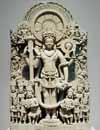 |
==Met
Museum timelines for South Asia, 1000-1400 CE: *Himalayan
region*; *North*;
*South*.
The
complexities of the Met's very helpful timeline still demand three
separate
parts. |
 |
==The
Brihadishvara Temple in Thanjavur (c.1000) is built by
the
Chola ruler Rajaraja ("King of Kings"). (His son Rajendra I pushes
Chola
rule up to the Ganges.) The temple inaugurates in South India a new
stage
of very large and elaborate temple complexes. Images: *kumbakonam*;
*Berger*;
discussion: *art
and archaeology*. More on medieval South Indian temples from "art
and
archaeology": *earlier*
and *later*
ones. [*Routes*] |
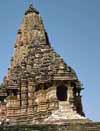 |
==The
Kandariya Mahadeva temple at Khajuraho (c.1004-35)-- oh
the
glory! I once spent a whole day just sitting near it, contemplating it
from different angles. It's the height of the height of temple
architecture,
a peer of the Taj Mahal. Images: *AIIS
Penn.*; *DSAL*;
*Berger*. [*Routes*] |
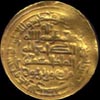 |
==Mahmud
Ghaznavi (r.998-1030) inherits from his father Subuktigin
a kingdom based in Ghazni (*N.
H. Dupree*), and augments his territory by overthrowing the last
(Turko-Hephthalite)
Hindu Shahi king. He makes a habit of raiding any convenient
neighboring
kingdoms to the west, east, and south, including Muslim ones. With all
that loot, when he makes Lahore his eastern capital in 1026 (*sacoins*),
he and his successors are able to turn Lahore into a cosmopolitan city
of real cultural and literary importance. His gold coins, like this
dinar,
are especially beautiful; he had plenty of looted gold for making them.
Discussion: *Ikram Ch.
2*. [*Routes*] |
 |
==Mahmud's
numerous raids (c.1005-26) on various Indian (as well as
Afghan) towns and rich temples culminate in a raid in 1026 on the
Somnath
temple in Gujarat (British Library views: *one*;
*two*),
of which much has been made in modern times. "Mahmud of Ghazni's raid
on
the Somanatha temple in 1026 did not create a Hindu-Muslim dichotomy.
Indeed
a rigorous historical analysis of five different narratives or
representations
of what happened yields surprising new insights," writes Romila Thapar
in "Somnath and Mahmud" (*Frontline*).
The Somnath raid later provides Wilkie Collins with the plot frame for
*The
Moonstone*
(1868). [*Routes*] |
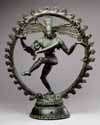 |
==Rajendra
I Chola's military conquests (c.1014–44): The rule of
Rajendra
I ("the Great") is noted for its warfare and conquests. In addition to
defeating the Palas in Bengal and conquering Sri Lanka (c.1017), he
undertakes
a massive naval campaign against the kingdom of Shrivijaya (Malaysia
and
Sumatra) because of conflict over the trade with China. |
 |
==al-Biruni's
"Tarikh al-Hind" (c.1020's-1030's): One of the leading
lights
of the Ghaznavid court, the Central Asian scholar Abu Raihan Muhammad
ibn
Ahmad al-Biruni (973- after 1050) (*wikipedia*),
composes his famous "Kitab fi-tahqiq ma li'l-hind" (Book of Inquiry
into
India). He seems to be the first Muslim to have learned Sanskrit.
Having
accompanied Mahmud on some of his raids, he profits by the Sanskrit
texts
he can acquire, and the learned Brahmins to whom he has access. He is a
real scholar--an all-round historian (*humanistic
texts*), astronomer, astrologer, mathematician, and geographer. |
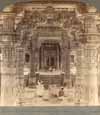 |
==Jain
temples in the medieval period: A major temple to
Adinatha
is completed at Mount Abu, in Rajasthan, c.1030. Jain temple-building
reaches
a peak between 1000 and 1400; other major sites include Shatrunjaya and
Girnar. Images of Mt. Abu: *DSAL*;
Berger has *Ranakpur*;
"art and archaeology" has *Shravana
Belgola* and *Ranakpur*.
See also *jain
world* and *jaina*. [*Routes*] |
 |
==Hazrat
Data Ganj Bakhsh in Lahore, and "Kashf al-Mahjub"
(1039-72):
'Ali ibn 'Uthman al-Jullabi al-Hujwiri, known as Hazrat Data Ganj
Bakhsh,
comes from Ghazni to Lahore in 1039, settles there, and stays till his
death in 1072; he is the earliest of many notable Sufi pirs to follow a
similar path. He is the author of, among other works, the first
important
history of early Sufism, called "Kashf ul-Mahjub" (Uncovering of the
Veiled),
written in Lahore. He is considered the patron pir of Lahore, and his
tomb
is a prominent and much-visited pilgrimage place in the city today.
More
on Sufism: *Sources
of Indian Tradition*. |
 |
==The
Silk Road matures: During this period, the famous Silk
Road
through Central Asia (*D.
Waugh*) becomes not only a source for luxury goods like silks and
spices,
but also more than ever a route for cultural exchange (*silk
road*). Some of the southern Silk Road routes pass through northern
Afghanistan and Pakistan. And how could it have happened without
camels? [*Routes*] |
|
|











